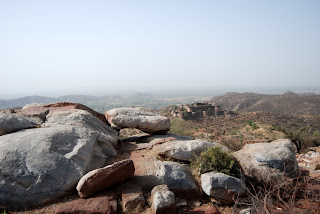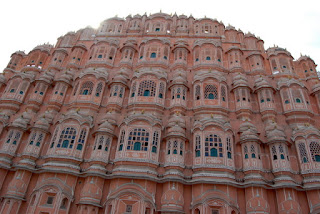Hanuman Temple, Samode
Indians who take Hinduism seriously spend a lot of time at it. I guess one of the reasons might be because there are few set times to visit temples, few rituals in which one is guided, and well, spending time at whatever activity is just something Indians like to do. Buying something from a shop is rarely a simple experience, if the shopkeeper sees you as a customer as having any potential worth whatsoever tea will be ordered and drunk together, and everything from your family to (of course) cricket will be discussed.
Visiting a Hindu temple is not entirely different, although there are subtle differences. The first would be the time taken to actually reach the temple, particularly in rural areas. In the hills surrounding Samode, temples are located at the top of ridges where no roads have ever been built, and no people have ever lived. You can arrive at these temples by taking any of 3-4 paths which start from villages at the bottom of the hills, and there isn’t any other way up but to walk. The walk isn’t taken as an inconvenience, rather it is part of the journey of preparing yourself to enter the temple. In Rajasthan, walking will start early to avoid the killer sun, which is at its most intense on top of those mountains, and will start making you heat up after about 8 am.
On our visit to Hanuman (the monkey god, sorry for the crude representation this word conveys) Temple, probably the most visited in the surrounds of Samode, we started out at about 5:30am from stairs located near Samode Palace (probably the reason most tourists end up here, a luxury hotel built into the ancient walls of the city- which receives coaches of package tourists each week at the moment, and is apparently full in the high season). As is becoming the norm somewhat here in India, I had heard some kind of rumour that either I misinterpreted or was simply false- that you had to climb 1200 stairs to reach the temple. At least this would be bearable when it was still cool in the morning. It didn’t take that long though- and we found out later that it was a much more modest 376. The real delight in reaching Hanuman for me though, was the walk across the top of the hills which separate Samode valley from the surrounding plains. The path stays on top of the mountains for the whole way, only dipping into a few valleys where rivers run in the monsoons. Legend has it that the path (which is constructed of stones of varying hues of red from the mountains themselves) was built by a devoted pilgrim who vowed not to set foot inside the temple until this path was complete. This is a recent legend, by the way, the wife of Dhananjay my work colleague claiming to have seen this man when she was young. He apparently lived on donations given by people who walked to the temple, and he died before the path was completed.
Pilgrims construct models of houses out of rocks on the path so that their future building projects might be blessed
Today the few choice trees that are on the mountain tops are located next to the path, and there are bird feeders and water hung in bowls from its branches. That means that especially early in the morning your walk is accompanied by the amazing variety of birds that frequent the hills of Samode at their most active and tuneful. The air is also very still, there being no one else around and little noise carrying up from the early-rising tractor drivers in the valley below. Add to that the changing colours of the rocks as the sun brightens and you have the perfect combination for preparing yourself to enter a religious temple and begin some self-contemplation.
The arrival at the temple itself gets you immediately familiar with its mascots- a few hundred Langoor monkeys which are hanging out on the rock face which is on the other side of the valley from the temple, plus some of the braver/hungrier ones swinging over the crevasse via the telephone wires.
The entrance into the temple takes you past a few small shops mainly selling Prashads (gifts for the gods- mainly Indian sweets and flowers) and a few breakfast and tea stalls. The normal practice is you bring something with you into the temple, leave some and hand the surplus over to your friends after your visit (Most of them are far too rich in sugar, and inedible by humans anyway ;-) The inside of temple itself is nothing extraordinary in terms of Hindu temples- a large idol of Hanuman- bright orange, and brightly coloured walls with shiny mirrors and reflective colours along with paintings from the life of Hanuman and the current gurus responsible for ensuring his honouring. Notable is a split-level that enables you to sit and contemplate Hanuman without being in the thoroughfare of people doing the same.
Our visit was a little inauspicious as it coincided with the day after one of the ‘lucky days’ to get married in the Hindu calendar, which meant that we had a constant procession of newlyweds accompanied by various groups (some of singing women) entering the temple. I tried to get rid of some of my super-sweet “gifts to the gods” but it was refused on the grounds that the groom was fasting (or at least that’s the excuse he came up with).
Our visit was followed by a breakfast of Cachori (sp?) in a spicy soup and some chai, and then we said good-bye to all the new Langoor mothers (almost every one had a newborn- there must be *something* good going on around the temple) and headed back before the day started heating up (i.e. before 8am ;-)
Some friendly donkeys on our trip back down






















